Swedish impressions of the Sherman
In 1946 and 1947, the Swedish army purchased a total of four surplus Shermans (first one M4A2 and one M4A4 without weapons, then a Firefly with the Continental radial engine and one M4 with the 10,5 cm howitzer) from the Brits, mainly to gain experience with foreign tank designs. A few attempts were made to purchase another 50 as surplus (they were very cheap, less than a thousand pounds each – you could get something like 50 modern, fully functional Shermans for the price of a single new build strv m/42), but this deal fell through because of difficulties with finding enough spare parts.
A number of automotive trials were done with these Shermans under field-like conditions, and a few reports were written. One of them – from a winter exercise in 1948 – follows, translated in its entirety. If you’d rather read the original Swedish, here it is in PDF format.
Archive reference: SE/KrA/0363/005:H/F I/3
Cover letter
To the Inspector of the armored troops.
Hereby the undersigned, whom pursuant to Ainsp/C no 23:8 of February 14 1948 was ordered to act as platoon leader of the Sherman platoon, respectfully remits a copy of “Memorandum with certain observations regarding the Sherman tanks in Swedish conditions during the field exercises of February 25 – March 4 1948”, which has previously been submitted to the Vehicle Bureau at the Royal Army Administration’s Ordnance Division.
Skövde, March 12 1948
Sten Korch
Captain
Memorandum
with certain observations regarding the Sherman tanks in Swedish conditions during the field exercises of February 25 – March 4 1948.
The Sherman platoon, which participated in the field exercises pursuant to order Ainsp/C no. 23:8 of February 14 1948, consisted of one Sherman II (airplane engine), one Sherman III (diesel engine) and one Sherman V (Chrysler engines) as well as one terrängpersonbil and one KP-bil, and belonged to the 2nd tank company. At the beginning of the field exercises, the platoon was attached to 11th bicycle rifle co., IIIrd armor infantry bn. I 16, which advanced along the road Granvik – Olshammar – Askersund. The platoon remained attached to this unit until the end of the exercises.
The road along which the platoon advanced was very bendy and hilly, and the road surface was mostly covered by hard ice. In several places the road was so narrow that passing or meeting other vehicles could only be accomplished with great difficulty. During the exercises large parts of the road were mined, and therefore mine hunting had to be done before the tanks could advance. Since the terrain did not permit off-road movement to pass the mined sections, the unit advanced slowly.
After the exercises had ended, the platoon drove to Skövde along the route Askersund – Olshammar – Karlsborg – Tibro – Värsås – Skövde.
Steering
The Cletrac steering has proven to be reliable and effective. The steering problems that have been observed on slippery roads is only caused by the track design (lack of spikes). There have been no issues whatsoever with the steering gears and no reparations or adjustments have been made, despite the drivers only having about an hour of training on these tanks before the field exercises started – they were thus rather unused to the tanks.
(Translator’s note: the fact that the author points out that no adjustments to the steering gears have been necessary as if this was a remarkable fact is because the problems the strv m/42 had with those – its steering gears wore out quickly and had to be adjusted frequently, especially when driven by inexperienced drivers.)
Track assembly
The track assembly has stood up well to all stresses it has been subjected to. It has not been necessary to replace any road wheels or track links. However, the wedges that lock the track pins in place have shown a tendency to loosen and fall off, which is caused by the nuts eventually screwing themselves loose. Even when such wedges have fallen off, neither the track pins nor the guide horns have shown any tendency to move. If a split washer was added under the nut and the nut then tightened hard, the wedge remained where it should.
On icy and slippery surfaces the tracks on the Sherman V, which have U-shaped gripping surfaces, have shown to be unsuitable. On many occasions the Sherman V therefore happened to slip off the road, and on three such occasions one of the tracks was thrown. In one case, the tank could be driven directly back on to the track, but in the other two the track had to be removed completely and placed in front of the tank, which was then driven back on top of it. This repair required about two hours each time. The Sherman V also had problems climbing many steep slopes because of the tracks slipping. By using extra track links (TN: possibly for a different tank? the document is quite unclear here and has a few hard-to-read handwritten corrections), these slopes could be climbed, but this took considerable amounts of time. These extra track links, in sets of 3-5, were placed under the tracks with the guide horns facing down, and this provided extra grip.
Since the Sherman V always was at the head of the column and showed poor performance on an icy road, the onlookers probably got the impression that the Shermans are hard to handle in winter. This is not the case, since the other two tanks never got stuck even once. When driving in terrain, all tanks passed the obstacles they had to pass.
During the drive from Askersund to Skövde on March 2nd (TN: after the end of the exercises), the Sherman V happened to skid off the road in a curve and at low speed drove into a cliff face with the left drive sprocket. The sprocket wheel was crushed and had to be replaced with one from the Sherman that was not participating in the exercises. After the repairs, the tank continued towards Skövde. About 1 km west of Mölltorp, the tank again skid off the road when going downhill, and threw one of its tracks. After pulling the tank back onto the road and re-mounting the track, the tank continued to Skövde without difficulties, since the road after that point was ice-free.
The Sherman III with rubber tracks (TN: surely he means rubber padded tracks?) has proven to perform the best on slippery surfaces and was the easiest to maneuver. To some extent, this is likely because it is the lightest (28 tons).
Transmission and power transfer
The transmissions has proven to be reliable and only one adjustment has been necessary. When the Sherman V collided with the cliff face, the fastening for one of the three clutch arms in the engine clutch was cracked. This was not discovered until the clutch started slipping in a slope after driving about 5 km. After adjustment, the tank could continue with no difficulties and without any noticeable slipping.
Engines
The engines have functioned impeccably and no repairs or adjustments have been necessary. There have been no problems at all with starting, despite the night time temperatures usually being around -15° C (TN: 5° F). No engine heaters were used and running the engines to warm them up was only done during the rest period on the 28th and 29th, when the engines were run at 10 hour intervals. All engines started on the first try, and on the Sherman V it was not even necessary to use the primer. This is remarkable, since the tanks are not intended or equipped for winter use, other than “blinds” (TN: or shrouds) having been mounted to the radiators.
Fuel consumption
The fuel consumption has been low, especially during pure road movements. During the entire field exercise, refueling was only done three times, and usually only one of the fuel tanks needed to be refilled. Altogether during the exercises, a distance of 215 miles or 350 km was covered.
Total fuel consumption during the exercises:
Sherman II: 1090 l
Sherman III: 680 l
Sherman V: 925 l
The high consumption on Sherman II was because the tank being driven about 30 km longer than the others and because it was used for towing on several occasions.
The drive Askersund – Skövde (104 km) resulted in the following fuel consumption:
Sherman II: 225 l
Sherman III: 160 l
Sherman V: 300 l
The platoon started out at 1830 hours on March 2, and arrived in Skövde at 2300 hours, after a 40 minute break in Karlsborg.
The high consumption on Sherman V was both because of the skids off road, where getting back onto the road consumed considerable amounts, and because the tank had to be driven on a low gear on the parts of the road that were the most slippery.
The Sherman II and V have been fueled with lättbentyl (TN: a 75/25 gasoline/ethanol mix), while the Sherman III was fueled with engine fuel oil (TN: diesel).
Oil consumption has been normal on all tanks.
Performance on roads
Other than the difficulties caused by the less than suitable track design on the Sherman V, the performance on roads has not been inferior to that of Swedish tanks to any meaningful degree. If the tracks had been fitted with spikes, many ditchings could surely have been avoided.
On one occasion, the night between the 1st and 2nd of March, it was intended to move the Sherman platoon from Stockshammar south of Askersund to a place northwest of the city along a rather poor road. Since this road was very narrow with steep banks and went through marshy terrain, and the tanks had to be driven with curtained lights, and that there was also a bridge that was forbidden to pass, this movement was discouraged and the platoon remained south of Askersund. In real field conditions where there need be no regard for property damage, and with drivers trained in night driving, this movement could have been accomplished with no great difficulty. The performance of the tanks themselves had nothing to do with the movement not being carried out as intended.
Performance in terrain
On all occasions where the situation demanded it – for example in the case of blown bridges, taking cover for air raids, supporting infantry, etc – the platoon moved in terrain with no difficulty. Despite the ground being poorly frozen, the tanks showed no tendency to dig down. On three occasions, streams between 2 and 5 meters wide were crossed. On one occasion, during the crossing of Igelbäcken, Sherman III got stuck, in part because the track spikes were not mounted and in part because of a misjudgement by the driver. When the next tank had passed, the Sherman III was towed up by it.
Repairs and adjustments
Repairs have only been done on Sherman V, namely changing out the left drive sprocket and removing and re-attaching tracks, which were thrown on two occasions.
The only adjustment done has been to the engine clutch on Sherman V, which was damaged when it collided with a cliff face.
Other observations
The tanks are spacious, both in the driver’s position and in the turret. Thanks to this, all activities are made easier, both when driving and when handling the tank in general. The heat from the steering gear and transmission makes it pretty easy for the driver to stay warm. Personnel standing in the turret, however, is greatly bothered by the air flow through the turret hatches which is caused by the powerful suction of the fan.
Since no radio was mounted in the tanks, the unit was difficult to lead. The commander has a very hard time to communicate with the driver when passing other vehicles etc, which led to some difficulties in such situations. If the tanks are intended to be used in further exercises, it is necessary to mount a radio, both for leading the unit and because road safety reasons require an intercom system to provide working communication within the tank.
A radio can be mounted without significant difficulty and connected using cables already existing in the tank. The costs can be estimated to about 75 kr per tank. In connection to this, the shielding could also be tested and compared to that of equivalent Swedish equipment.
Final assessment
The tanks have proven to be reliable and suitable to field conditions. This has been showed by the very few repairs and adjustments that have been necessary, despite the tanks not having gone through any complete overhauls after arriving in Sweden.
The general impression is that the tanks have showed that they respond well to the demands one could make of them. If the tracks had been spiked the driving performance would have been even better. They have been easy to drive, despite the drivers having very little training in winter driving, and the unit has been able to complete the tasks it has been assigned.
The best property is the reliability of the vehicles, which makes one feel secure in leading the unit, with certainty that the equipment will hold up. There is no need to be anxious about the steering gears running hot or malfunctioning after driving on a bendy road, that one tank might have to stop after an oil or water leak or somesuch, nor that the fuel reserves might be running low after a 100 km road movement. (TN: all of these problems he mentions being anxious about were very common on the strv m/42.)

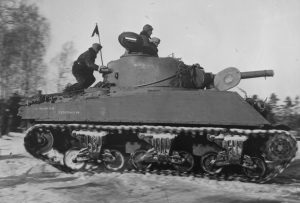
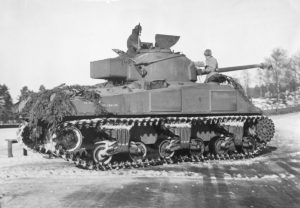
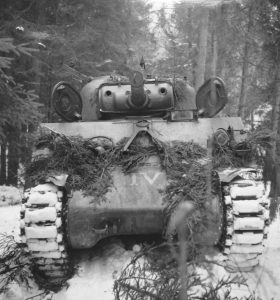
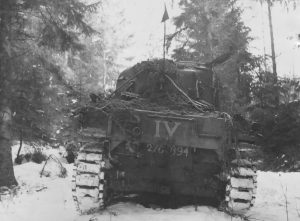
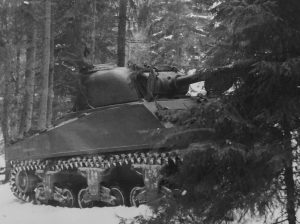
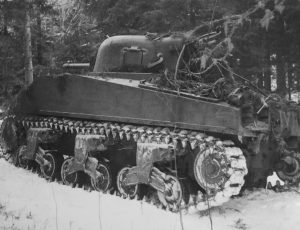
Hi there…
The Sherman rear view has the old UK T-number – T-270894. This makes it the Sherman 1B 105mm…do you have the numbers of the other three vehs ?
Roddy